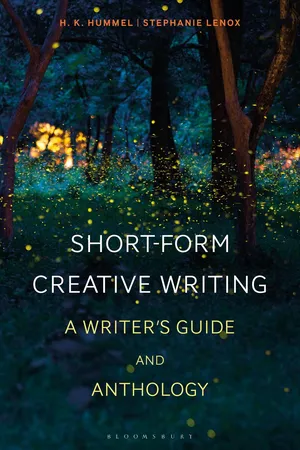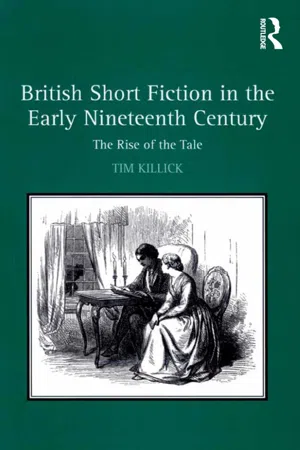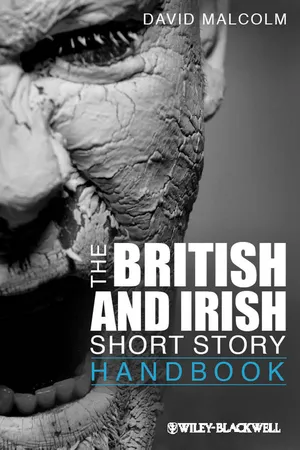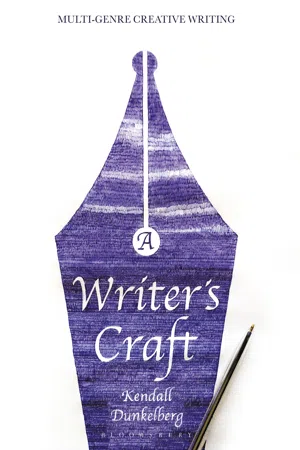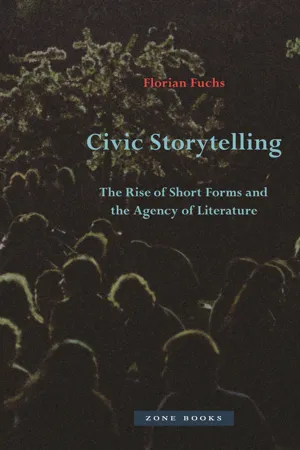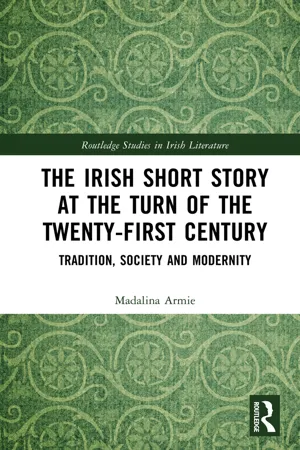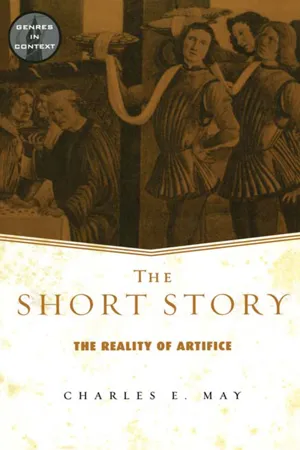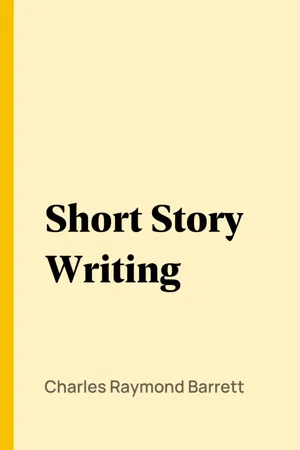Literature
Short Fiction
Short fiction refers to brief, concentrated works of prose fiction that typically focus on a single character, event, or idea. It often emphasizes conciseness and efficiency in storytelling, making it a popular form for exploring complex themes in a compact format. Short fiction can encompass a wide range of genres and styles, from traditional short stories to flash fiction and microfiction.
Written by Perlego with AI-assistance
11 Key excerpts on "Short Fiction"
- eBook - ePub
Short-Form Creative Writing
A Writer's Guide and Anthology
- H. K. Hummel, Stephanie Lenox(Authors)
- 2018(Publication Date)
- Bloomsbury Academic(Publisher)
The experience of readers in the nineteenth century continued to change with periodicals, which could be produced cheaply and distributed efficiently to a more centralized urban readership. These publications gained prominence over the course of this century and provided a venue for short-form writing. Writers of short stories, brief anecdotes, sketches, and tales could sell their stories to periodicals and make a profitable living. Short-form writing has always existed alongside other forms of literature, but it was this period in history that popularized it and also made it profitable for writers. Increased interest in short pieces solidified formal characteristics that emphasized thematic unity and restraint.It wasn’t until the later part of the twentieth century that a tendency toward extremely short stories came to the attention of editors Robert Shapard and James Thomas. In their reading, they noticed works of fiction totaling no more than a few pages in length that seemed to position themselves between the genres of fiction and poetry. These highly compressed narratives took cues from the short story, but they also contained language charged with the lyric intensity of a poem. In the first of a series of anthologies, Shapard and Thomas coined the term for these stories: flash fiction. They were not the first to attempt to label these extremely brief stories, and they certainly weren’t the last. In fact, more than any kind of writing, short-form fiction has inspired the most diverse array of appellations, not just in English but in languages from around the globe.The word count for these short forms varies just about as much as the names that have been used to describe them. Yet they all point to a kind of writing that thrives on limits. In his introduction to Flash Fiction: Very Short Stories, James Thomas points to Ernest Hemingway’s “A Very Short Story,” published in 1925, as an archetype of the short form. Thomas used this story to set the limit of 750 words for the stories in his anthology. His editorial partner Robert Shapard, in his series of Sudden Fiction - eBook - ePub
British Short Fiction in the Early Nineteenth Century
The Rise of the Tale
- Tim Killick(Author)
- 2016(Publication Date)
- Routledge(Publisher)
109 Reid, The Short Story, p. 4.10 Harris, British Short Fiction, p. 12.A bewildering variety of definitions and conventions have been proposed for the short story. Frank O’Connor, a short story writer himself, asserts that the genre is one that has ‘never had a hero’, and therefore lends itself to stories of outsiders and society’s marginalia.11 In her contribution to the useful essay collection Short Story Theory at a Crossroads, Mary Rohrberger argues that an intricate lyrical condition is the defining characteristic of the genre. The short story, she claims, demonstrates a movement away from the ‘simple narrative’, which accomplishes meaning through basic ‘ironic reversals’, and instead tends towards a final effect derived from complex and inconclusive narrative patterning: ‘where patterning is defined by a principle of organization and where degrees of tensions or expectations and gratifications involve us in a steady rhythmic process toward a particular ending necessitated by the pattern involved.’12 In the same essay collection Charles May offers a contrasting view of the short story, and argues that it has managed to avoid the elaborate realism of the novel and retain its connections to mythic, elemental story forms. For May, the genre operates through a poetic technique of ‘metaphoric projection and hierophantic revelation’, and in doing so retains strong links to its romance heritage.13 Definitions and counter-definitions roll on and on: from Formalist methods of motif-charting, derived from Vladimir Propp’s work on the folktale, to imposing the limits of genre by maximum word-count and number of pages, the delineation and classification of Short Fiction has engaged successive generations of literary critics.14 - Maria Löschnigg(Author)
- 2022(Publication Date)
- Routledge(Publisher)
There have been multimodal forms of Short Fiction (e.g. Schoemperlen), flash fiction (e.g. Atwood), and iconic and strongly metafictional modes of writing (e.g. Bowering). Orality, as rendered most memorably in Thomas King’s trickster stories, has engendered unique forms of narrative expression, as will be shown in Chapter 8. Another format which has come to be seen as quintessentially Canadian is the short story cycle (Lynch 2001). Due to its appearance in all periods of Canadian Short Fiction and its manifold thematic orientation, it will receive attention in many chapters and will be addressed in a number of contexts. In addition to these forms, three modes of narrative discourse have made a strong imprint on Canadian Short Fiction: the epistolary mode, you- and we-narration, and the composite or fragmented story. The distinct aesthetic potentials of these rather unconventional variants will be given space in Chapters 5 and 6, where the focus is more strongly on experimental aspects of contemporary Canadian Short Fiction. As this book will demonstrate, the Anglophone Canadian short story is characterised by an astounding plurality. Nonetheless, it will be necessary, before turning to developments, individual authors, specific thematic concerns, and aesthetic forms in the following nine chapters of this book, to first attempt a definition of the generic parameters of the short story as such. 1.2. What Is a Short Story? The short story is neither a miniature novel nor is it comparable to a novel’s chapter; still, it is shortness which serves as the basis for a definition and understanding of the specific aesthetic qualities of the genre. In other words, it is essential to investigate the nature and effect of the short story’s shortness – what Barbara Korte (2003 : 5) has aptly termed its calculated brevity and what A.L. Kennedy (2008 : 3) has pointedly described as small in a way that a bullet is small- eBook - ePub
- David Malcolm(Author)
- 2012(Publication Date)
- Wiley-Blackwell(Publisher)
Part 2 Issues in Short Story Criticism DefinitionsWith justice, it has traditionally been seen as difficult to define the short story. As Renate Brosch remarks: “Die short story ist sympatisch resistant gegnüber Definitionen” (The short story charmingly resists definitions) (2007: 9). There are several reasons for this difficulty.First, there is a problem of names. The term “short story” is used, according to Reid (1977: 25) and others, only from the 1880s. Neither Poe nor Hawthorne wrote of their narratives, which we would now call short stories, as such, but referred to them as “tales” or “sketches.” Such usage endures into the late nineteenth century. Writers like Crackanthorpe and James designated what they wrote as “impressions” or “vignettes” or “nouvelles” (Fowler 1987: 336). Arthur Symons, writing in 1897, praises Maupassant as an unrivalled author of the “nouvelle, or short story” (qtd. in Stanford 1968: 23). Both Orel (1986: 96) and Harris (1979: 10) point to the terminological confusion that bedevils discussions of Short Fiction in the nineteenth century. Several different terms have traditionally been used to discuss this type of text: tale, sketch, fable, conte , novella, and nouvelle .The second reason for difficulty in definition is the lack of distinctive subject matter in the short story. Short Fiction, whatever one calls it, deals with the same story materials as novels: supernatural occurrences, love, psychological change, historical conflict, space travel, the adventures of talking animals, and so on. Several short stories do, indeed, present relatively static kinds of action. A great deal happens in Virginia Woolf's “Kew Gardens” or Jean Rhys's “Hunger,” but the action is not of the kind that forms the skeleton of so many novels: adultery, invasion, murder, journeys, and social conflict, for example. Head (1992: 16–17) and Hanson (1985: 55–81) write of the importance of the less traditionally plotted story for the development of twentieth-century Short Fiction. However, the relatively inert (only in one respect, of course, for the psychological movements of the stories by Woolf and Rhys mentioned above are very substantial) is only one kind of short story. There are many others, full of the kind of action that equally well appears in longer fictions. - eBook - ePub
A Writer's Craft
Multi-Genre Creative Writing
- Kendall Dunkelberg(Author)
- 2017(Publication Date)
- Bloomsbury Academic(Publisher)
In a novel, you have anywhere from 200 to 1,000 pages (or more) to tell your story. In a short story, you have anywhere from 4 pages to 40. Any longer, and you have a novella. Any shorter, and what you are writing is probably flash fiction. Fiction can be any length, but how you set about telling your story will depend on what length you are shooting for, and for the beginning short story writer, this is often one of the biggest challenges. If you are shooting for 7 to 15 pages (a reasonable length for a story, especially if you are also working on other genres), then you really only have room to develop a few scenes. Everything has to be focused around a few central moments, and you have to find a way to reveal essential background details that help us understand those moments without overburdening the story with a lot of scene.A short story will likely involve two to three main characters with a supporting cast of maybe two to three more. In a novel, you might tell the story of two whole families and take time to develop each of those characters; in a story, you will focus on a couple of main characters and their closest relationships.Time is also more limited in a short story than in a novel. A short story may take place in one scene that lasts an hour or less, or it may take place over the span of a few days. At least, the main time frame of the story will be fairly limited, though there are techniques to weave other times into the main narrative, as we shall discuss later.The action of the short story is also very limited. Whereas a novel may tell the story of a character’s life or one period in the character’s life, a short story deals with a very specific series of events. The action of a story begins very soon, usually on the first page, with very little exposition. A novel may take an opening chapter or two to set the stage and only then introduce the initial conflict. In a short story, every action must be unified and related to the central conflict. There is no room for digression or for long exposition. The novelist can afford to be a little self-indulgent; the short story writer must be brutal in cutting any unnecessary detail. - eBook - ePub
Civic Storytelling
The Rise of Short Forms and the Agency of Literature
- Florian Fuchs(Author)
- 2023(Publication Date)
- Zone Books(Publisher)
INTRODUCTIONTwo Ontologies of Prose Literature, Short Form versus NovelThis study stems from a seemingly simple question: Why did short narrative forms such as the novella, fable, and fairy tale suddenly, yet widely emerge throughout Europe and the Americas in the decades around 1800? Attempts to answer this question have tended to take the form of simple chronology or sociohistorical speculation, assuming that these short forms were by-products of increasing literacy and of the arrival of reading culture. Such speculation points to the radical changes in reading culture of this period, during which authors experimented with genres, publishers and book traders diversified their products, reading practices broadened, and new pedagogical, religious, and journalistic uses for short pieces developed. The causes for the rise in short forms are myriad, goes the argument, and attempts to pin the emergence of the short form on a single causative factor are futile.Sociohistorical answers, however, offer only metaliterary reasons for the rise of short forms and thus devalue literature’s own role in shaping new genres and the communicative functions they embody. In fact, as we will see in the chapters of this book, there are fundamental and far-reaching causes for the rise of short narratives within the appearance of literature itself. In the language of literary studies, one could say that short forms partook of the deep phenomenological change that occurred between the fourteenth and seventeenth centuries in how textual fiction behaved between the reader and the world. During this era, what is called classical and medieval “poetry” — drama, lyric, and epic works written in verse and abiding by the poetic rulebooks from Aristotle’s Poetics to Scaliger’s Poetices libri septem - eBook - ePub
The Irish Short Story at the Turn of the Twenty-First Century
Tradition, Society and Modernity
- Madalina Armie(Author)
- 2022(Publication Date)
- Routledge(Publisher)
Previously, and indeed since then, the term has been substituted—to the detriment of achieving a more concise definition—by a variety of alternative terms, which were used indiscriminately and interchangeably, including “impression”, “fable”, “sketch”, “novella”, “tale” and “vignette”. Frequently, this lack of terminological clarity and its brevity make scholars claim that the writing or reading of a short narrative can be done in a short period of time, and that in this sense, the short story is a good fit for the frenetic rhythm of contemporary readers’ lives, with the weary day-to-day experience of a housewife or the stressed situation of working women around the world (Lee, The Secret Self). These associations in what concerns the Irish short story, in some way or other, try to explain on the one hand the predilection of women writers for the form, and on the other hand the success of the short story in Ireland in recent decades. However, such claims are brought into question by the complexity of the processes of writing and reading short stories, in that, “[s]tories require concentration and seriousness” (Moore), and a continuous involvement is necessary in both processes. Second, it should be noted how greater attention has been paid to the contrast between the short story and the novel in academia. In relation to this, and given that it supports the thesis that lies at the very heart of this volume, is relevant to highlight Wain’s observation as to the self-containing and rewarding nature of the short form and its capacity to portray snapshots of reality: The short story, vis-à-vis the novel, is almost exactly like a drawing as compared to the painting. When we see a perfectly successful drawing we never say “How good that would have been if only it could have been a painting”. A painting is an entirely different thing. It has a depth, and it has a richness that the drawing can’t have. The drawing catches a moment—forever - eBook - ePub
- John Court(Author)
- 2008(Publication Date)
- Routledge(Publisher)
Chapter 3
Short stories and their structure
The modern short story is a literary fascination. As Malcolm Bradbury writes in The Penguin Book of Modern British Short Stories:The short story has become one of the major forms of modern literary expression…. For what we usually mean by the genre is that concentrated form of writing that, breaking away from the classic short tale, became, as it were, the lyric poem of modern fictional prose…. The modern short story has therefore been distinguished by its break away from anecdote, tale telling and simple narrative, and for its linguistic and stylistic concentration, its imagistic methods, its symbolic potential. … In fact, for many prose-writers it has become closest to representing the most ‘poetic’ aspect of their craft.(1987, p. 11)V.S. Pritchett, in his introduction to The Oxford Book of Short Stories , seems to agree:The short story springs from a spontaneously poetic, as distinct from a prosaic, impulse – yet it is not ‘poetical’ in the sense of a shuddering sensibility. Because the short story has to be succinct and has to suggest that things that have been ‘left out’, are in fact there all the time, the art calls for a mingling of the skills of the rapid reporter or traveller with an eye for incident and an ear for real speech, the instincts of the poet and ballad-maker, and the sonnet writer’s concealed discipline of form. The writer has to cultivate the gift for aphorism and wit. A short story is always a disclosure, often an evocation – as in Lawrence or Faulkner -frequently the celebration of character at bursting point: it approaches the mythical. Above all, more than the novelist who is sustained by his discursive manner, the writer of short stories has to catch our attention at once, not only by the novelty of his people and scene, but by the distinctiveness of his voice, and to hold us by the ingenuity of his design. … A modern story comes to an open end. People are left carrying the aftermath of their tale into a new day of which, alarmingly, they can as yet know nothing. - eBook - ePub
The Short Story
The Reality of Artifice
- Charles May(Author)
- 2013(Publication Date)
- Routledge(Publisher)
Most writers have testified to its essentially subjective nature. Sean O'Faolain calls it an "emphatically personal exposition." 49 William Carlos Williams says he thinks it a good medium for "nailing down a single conviction. Emotionally." 50 V. S. Pritchett says the good short story writer knows he is putting on a personal, individual act: he catches "a piece of life as it flies" and makes "his personal performance out of it." 51 Frank O'Connor says that the short story is the nearest fictional form to lyrical poetry: "A novel requires far more logic and far more knowledge of circumstances, whereas a short story can have the sort of detachment from circumstances that lyric poetry has." 52 William Faulkner says that in the novel one can be more careless, put more "trash" in, but "in a short story that's next to the poem, almost every word has to be almost exactly right." 53 British writer Elizabeth Taylor has suggested that the short story, by its lyrical nature, its sustaining of one mood throughout, can give an impression of "perfection" and the feeling of "being lifted into another world, instead of rather sinking into it, as one does with longer fiction." 54 Maurice Shadbolt says that the challenge of the form is to pull as much of life as the story can bear into the fewest pages and, therefore, to produce, "if possible, that hallucinatory point in which time past and time future seem to co-exist with time present, that hallucinatory point which to me defines the good or great short story." 55 And Torborg Nedreaas of Norway has another metaphor that reveals much about the form: it is like an oval, a drop - Erin Fallon, R.C. Feddersen, James Kurtzleben, Maurice A. Lee, Susan Rochette-Crawley(Authors)
- 2013(Publication Date)
- Routledge(Publisher)
Whether they bespeak the bases and values of culture in myth and folktale or foster a sense of right and wrong in fables, stories organize and transmit sequences of human events and experiences into meaningful units. The most fragmentary of tales still suggests some relationship between present, past, and future. As Lohafer and Clarey say, “Story is a human frame for experience” (211).Fortunately, we need not fathom the abyss of the origin of language to sketch some important moments in the development of the short story as a literary form. Despite the fact that James Cooper Lawrence in 1917 claimed the short story to be the oldest of all “literary types” and the basis for both ballad and epic (65–66), many critics today make clear distinctions between the modern literary short story and earlier short narratives. A brief overview of the history of the tale may help us to put the development of Short Fiction as an identifiable genre into perspective.Short narratives have for centuries served several purposes; they have preserved, explained, entertained, and instructed. Oral accounts of battles and other human trials have regaled listeners and provided vivid living memories of people and events. Other tales have given meaning and order to life by explaining origins or dramatizing human purposes and values. Short narratives abound in religious texts of most cultures. Stories in the Bible, from Cain and Abel to the parables of Christ, define the history of a people’s relationship to God and each other. Among the ancients, we find the fables of the Greek slave Aesop, which date from the sixth century B.C . Endowing animals with human characteristics, fables teach moral lessons, and we still find them not only in children’s stories and animated cartoons (“The Three Little Pigs”) but perhaps also in George Orwell’s Animal Farm- eBook - ePub
Short Story Writing
A Practical Treatise on the Art of The Short Story
- Charles Raymond Barrett(Author)
- 2007(Publication Date)
- Perlego(Publisher)
The Dramatic Story is the highest type of the short story. It requires a definite but simple plot, which enables the characters to act out their parts. In its perfect form it is the "bit of real life" which it is the aim of the short story to present. It is the story shorn of all needless verbiage, and told as nearly as possible in the words and actions of the characters themselves; and it possesses a strong climax. Therefore it demands the most careful and skillful workmanship, from its conception to its final polishing. It is the most modern type of the short story.(a) The short story has Dramatic Form when the author's necessary comments correspond to the stage directions of the drama. Such a story is, in fact, a miniature drama, and is often capable of being acted just as it stands. It has a definite plot, but it is developed by dialogue as frequently as by action. It is the extreme of the modern tendency toward dramatic narrative, and is just a little too "stagey" and artificial to be a perfect short story. It is, however, in good literary standing and in good favor with the public, and it is most excellent practice for the tyro, for in it he has to sink himself completely in his characters. Examples: Hope's "The Dolly Dialogues;" Kipling's "The Story of the Gadsbys;" and Howells' one act parlor plays, like "The Parlor Car," "The Register," "The Letter," and "Unexpected Guests."(b) A short story has Dramatic Effect when it deals with a single crisis, conveys a single impression, is presented chiefly by the actors themselves, and culminates in a single, perfect climax. It may, or may not, be capable of easy dramatization. It is less artificial than the story of pure Dramatic Form
Index pages curate the most relevant extracts from our library of academic textbooks. They’ve been created using an in-house natural language model (NLM), each adding context and meaning to key research topics.
Explore more topic indexes
Explore more topic indexes
1 of 6
Explore more topic indexes
1 of 4
